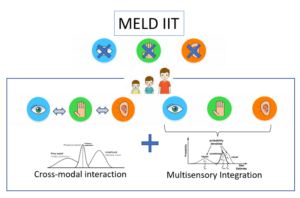MELD Projects
Monica Gori

The development of multisensory skills still needs to be better understood. Our activity shows that sensory modalities’ interaction and integration are strictly interconnected. However, how these two mechanisms work at different ages considering their longitudinal development, is a mystery. Within the MELD project, we will focus on visual-tactile/haptic and audio-tactile/haptic processing considering typical and atypical sensory impaired children to determine behavioral and neurophysiological levels when and how sensory modalities scaffold multisensory integration. To do so within the consortium, we will develop simple and complex perceptual scenarios to modulate the task complexity and consider low-level and higher-level sensory processing.
Micah Murray
The CHUV-UNIL team will particularly focus on the role of early life experience on multisensory development, including but not limited to premature birth and schooling environment. The CHUV-UNIL team will also put particular emphasis on how multisensory processes provide the scaffolding for higher-cognitive development and thus provide a strong candidate access point for remediation and potential prevention. Finally, the CHUV-UNIL team will concentrate effort on bridging sensation, perception and resultant movement in immersive environments.
Nick Turk-Browne & David Lewkowicz
The Yale site will contribute its unique expertise and facilities by pursuing studies in infants and toddlers, in addition to young children. These include fMRI studies in awake infants and toddlers to assess multisensory integration across the early developing brain, as well as behavioral studies with eye-tracking to investigate temporal binding and perceptual segregation of audiovisual speech.
Mark Wallace

Vanderbilt is the primary site for the consortium, and oversees all aspects of the consortium’s work. One of the major emphases at the Vanderbilt site will be assessing various facets of multisensory development in children from ages 5-21. In addition, Vanderbilt will serve as a focal site for examining how multisensory function differs in its development in neurodiverse populations, such as in autistic individuals.